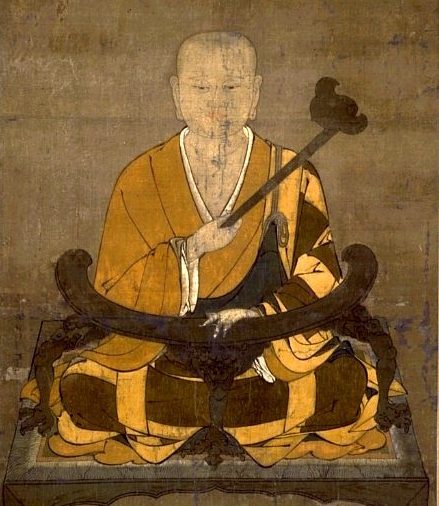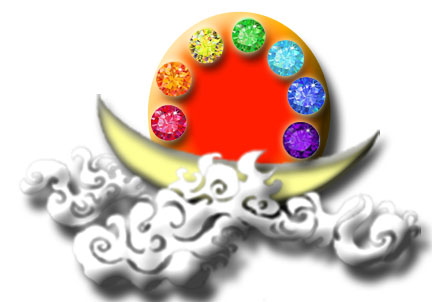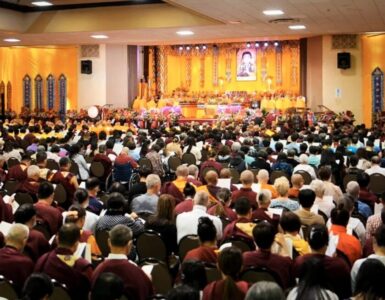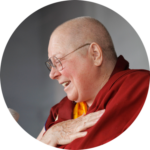
At the recent retreat where we focused on the “Supreme and Unsurpassable Mahamudra of Liberation (SAUMOL),” we had considerable discussion on the meaning of certain terms, especially those relating to meditation. We had both Mahayana and Theravada students present at this retreat and it became obvious that we needed a more common language to understand terms that are common in both traditions but may carry different meanings in each. This is especially important for the SAUMOL as it offers a dharma that in intended for all Buddhists and even non-Buddhists. Although I cannot promise that we will have definitive meanings given in the final translation of the SAUMOL, I did find a treatise that may help. Many of us westerners who have studied and practiced Buddhism have done so with the help of texts from the Japanese Zen or Theravada traditions. More recently there have been many Tibetan masters who have also provided meditation manuals from their traditions as well. We have not been blessed as much with translations of teachings from the rich traditions of the ancient Chinese Masters. This is true in our own lineage from H.H. Dorje Chang Buddha III as well. The Chinese students had Pa Mu’s The Dharma of Concentration and Visualization Essential for Enlightenment, but that was never translated into English. I was able to read a very preliminary translation and know that it covered three topics: mental quiescence or calm abiding, known as zhi or 止 in Chinese and shamatha in Sanskrit); contemplation, known as guan or 觀 in Chinese, vipashyana in Sanskrit, vipassana in Pali, and “insight meditation” in many western sanghas; and a Vajrasattva visualization practice. I am afraid that the translation that I had was not very helpful. The SAUMOL also includes a Vajrasattva visualization practice and many references to practicing zhiguan as the two types of meditation. It is assumed that the reader understands how to do those types of meditation
Quite by accident, I found and reread a treatise by a sixth century Chinese Tripitaka Master, Sramana Zhiyi (Bhikshu Chih-i), the founder and Fourth Patriarch of the Tiantai Sect, that is considered the first practical manual of meditation available to the Chinese. Master Zhiyi, a contemporary of Bodhidharma, was well versed in the broad tradition of Indian asceticism and famous for his elaborate and systematic classification of the Buddha’s teachings and the first major teacher to form an indigenous Chinese system. According to Zhiyi, the five periods of the Buddha’s teachings (which he compared in order to the five stages of milk: fresh milk, cream, curds, butter, and ghee or clarified butter) were:
- The Flower Garland period – taught immediately after the Buddha attained Enlightenment, lasting 3 weeks, but the teachings at this time were incomprehensible to all but advanced bodhisattvas.
- The Agama Period – taught at Deer Park, and lasting 12 years. These consisted of the most elementary teachings of the Buddha including karma, rebirth, the Four Noble Truths, etc. These are found in the Theravada canon in Pali and in Sanskrit and the Chinese canon as the Agamas.
- The Correct and Equal Period – lasting 8 years. This marks the Buddha’s teachings that begin to transition from so-called “Hinayana” teachings to Mahayana ones.
- The Wisdom Period – lasting 22 years. The teachings here consist of the Perfection of Wisdom (Prajnaparamita) teachings among others. Here, the teachings were intended to demonstrate that the classifications of Hinayana and Mahayana were expedient only, and that they were ultimately empty.
- The Lotus and Nirvana Period – lasting 8 years. The teachings of this final period mark the most “perfect” teachings, namely the Lotus Sutra and the Mahayana Nirvana Sutra, which encompass the Buddha’s original intention.
Master Zhiyi also organized the teachings of the Buddha into four types based on the capacity of the listener (sudden, gradual, indeterminate, and secret or esoteric) and by the four types of sources (Hinayana, Mahayana, both, and those that transcend both).
I found Master Zhiyi’s treatise, The Dharma Essentials for Cultivating Stopping (Shamatha) and Contemplation (Vipashyana) and Sitting in Dhyana, which Bodi Wentu translates as A Summary of the Dharma (or Dharma Essentials) Regarding the Cultivation of Samatha and Vipasyana Sitting Meditation, useful, partly because of its Chinese origins and partly because Master Zhiyi was trying to synthesize the many streams of Buddhist teachings coming out of India at the time he wrote it in 594 CE. I feel we are in a similar situation with trying to understand a Chinese Buddha Master in the context of the many Buddhist traditions that have evolved and are now being taught in the West. It also helps us understand a problem in our understanding of correct meditation practice that the SAUMOL corrects. Zhiyi does talk about the need to keep the precepts and the need to approach meditation with the correct balance and appropriate emphasis, but the emphasis of this manual is on the cultivation of mind and not the cultivation of character that the Buddha Master so often says must come first. It is no accident that we only have the parts of the SAUMOL that deal with the cultivation of character and that the essence and dharmas that deals with dharma practice are not included. Such is our karmic condition.
Meditation is very popular in the west now, but it is offered to give us peace and tranquility or improve our concentration or even to realize emptiness, but without the part that requires self-cultivation with the goal of actually becoming a Buddha. That is the great gift that our Buddha Master has come to offer to us.
CLICK for on-line translation of Master Zhiyi’s The Dharma Essentials for Cultivating Stopping (Shamatha) and Contemplation (Vipashyana) and Sitting in Dhyana by Bhikshu Dharmamitra.
A revised version of this translation is available from Kalavinka Press, Amazon, or Barnes & Noble as The Essentials for Practicing Calming-and-Insight & Dhyana Meditation with a companion work also by Master Zhiyi, The Six Dharma Gates to the Sublime.




Add comment